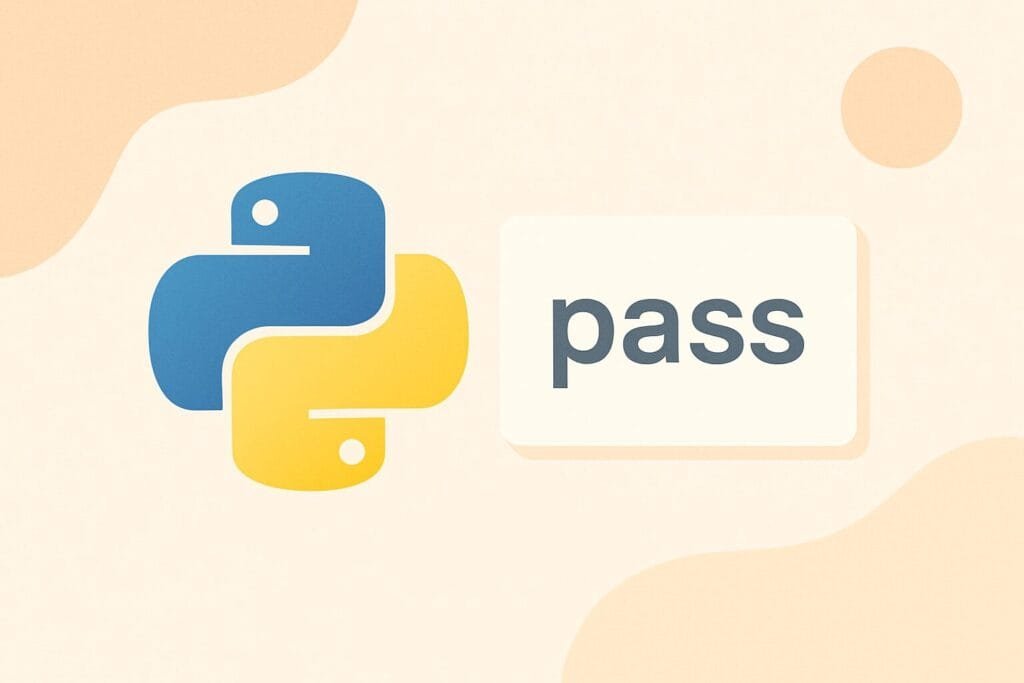When writing Python code, you may encounter situations where you need to define a block of code that does nothing for the moment but should not break your program. This is where the Python pass statement comes into play. It is one of the most commonly used placeholders in Python and is extremely useful when building classes, functions, or loops that are not yet fully implemented.
What is the Python Pass Statement?
The pass statement in Python is a null operation — meaning it does nothing when executed. It is used as a placeholder in blocks of code where Python syntax requires something to be present, but the programmer has not decided what to write yet.
Without the pass statement, leaving a code block empty would result in an IndentationError. Therefore, pass ensures your code remains syntactically correct while you work on other parts of your program.

Basic Syntax
pass
Why Use the Pass Statement?
- Code placeholder: It helps developers outline code structure before filling in the details.
- Avoid syntax errors: Python does not allow empty code blocks;
passprevents errors. - Improves readability: Other developers can understand that a block is intentionally left blank for future implementation.
Examples of Python Pass Statement
1. Using Pass in Functions
Sometimes you define a function but haven’t implemented its logic yet. You can use pass as a placeholder.
def not_ready_function():
pass
print("The program runs even though the function is empty.")
2. Using Pass in Classes
When defining classes in Python, you may want to leave them empty until later development. Without pass, Python would raise an error.
class EmptyClass:
pass
obj = EmptyClass()
print("Object created successfully from an empty class.")
3. Using Pass in Loops
If you need to set up a loop but haven’t decided what actions to perform, pass helps keep the loop valid.
for i in range(5):
pass
print("Loop executed successfully without performing any action.")
4. Using Pass in Conditional Statements
Sometimes while designing conditions, you may want to skip a particular block. The pass statement lets you do that.
x = 10
if x > 5:
pass # Implementation will be added later
else:
print("x is not greater than 5")
5. Practical Example: Application Prototype
Imagine you are designing a banking system. You might create function outlines first and then implement the logic later.
class BankAccount:
def __init__(self, balance=0):
self.balance = balance
def deposit(self, amount):
pass # Will add logic later
def withdraw(self, amount):
pass # Logic not implemented yet
def display_balance(self):
print("Current balance:", self.balance)
# Create an object
account = BankAccount(100)
account.display_balance()
Here, the deposit and withdraw methods do not yet have logic, but the code runs without errors due to the pass statement.
Difference Between Pass, Continue, and Break
It is common for beginners to confuse pass with continue and break. Here’s a comparison:
| Keyword | Function | Usage |
|---|---|---|
| pass | Does nothing | Placeholder in blocks of code |
| continue | Skips the current iteration | Used in loops to skip execution of the remaining code for the current iteration |
| break | Exits the loop entirely | Used to terminate loops prematurely |
for i in range(5):
if i == 2:
pass # Does nothing
elif i == 3:
continue # Skips the rest of this iteration
elif i == 4:
break # Exits the loop
print(i)
Best Practices for Using Pass Statement
- Use
passonly when necessary to avoid clutter in code. - Document why a
passis used with a comment for clarity. - Replace
passwith meaningful implementation as soon as possible.
Conclusion
The Python pass statement is a simple yet powerful tool for structuring your code during development. It allows you to maintain correct syntax while leaving certain blocks unimplemented. By using it effectively, you can design prototypes, outline functions, and prepare loops without facing errors. Understanding the difference between pass, continue, and break is also crucial for writing clean and efficient Python programs.
If you are new to Python, the pass statement will become a valuable ally as you structure your code and gradually implement logic. For more on official documentation, you can check Python Docs.

